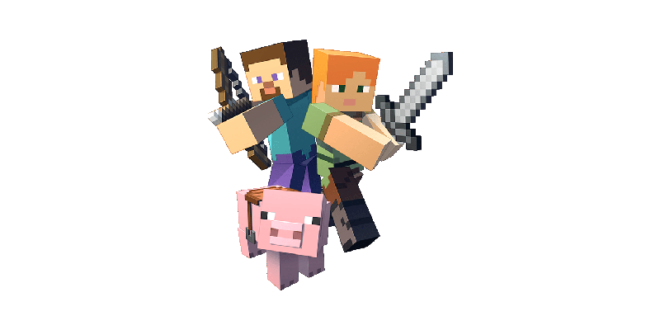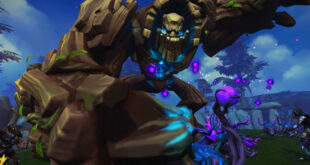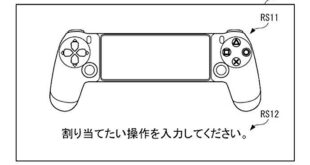Ever since the glorious days of the 8-bit era, console gaming has bloomed into a thriving entertainment industry. However, the players who also did their growing up alongside it have led to a massive change in the gaming demographics. Indeed, most console games these days are created with adult audiences in mind, leaving kids games dramatically underserved in the mainstream release schedule. It’s not that kids aren’t playing games any more, but with more children swapping consoles for smartphones, is there a future for kids gaming on consoles?
Let’s start with the facts. According to the latest GameTrack Digest (ISFE/Ipsos Connect), 25 per cent of the UK gaming population in Q4 2016 fell into the six to 14 year age group. That might not sound like a lot, but drill down a little further, and you’ll find 68 per cent of kids aged six to ten and 77 per cent of children from 11 to 14 play video games in the UK – the highest rate of any age group.
There’s clearly a lot of interest, then, but what titles do kids actually play, and on what platform? According to Klosters Trading Corporation’s president Lutz Muller (pictured left), “most games played by children [in the US] fall into the category of social games.”
This would explain why kids tend to play on mobile instead of consoles nowadays, particularly since consoles often offer few games that fall into the social bracket.
Muller continues: “What differentiates consoles from smartphones are four things: clock speed, graphics, screen resolution and memory. The game and hardware developers targeting the adult community are extremely focused on them, whereas the limits imposed by smartphones by definition require a type of game that is much more attuned to the needs of children. I hence see a situation where the two development streams, consoles versus mobile, continue to diverge and basically divide the consumer population into two very separate groups: children with smartphones and adults with consoles.”
The hardware issue is particularly important. Despite smartphones often costing more than your typical console over the course of a two-year contract, they’re also considered more disposable than a box that goes under your TV. With four out of five adults now owning a smartphone in the UK (according to Deloitte’s Global Mobile Consumer Survey 2016: UK Cut), it’s also clear to see why parents find it easier to let their kids play on mobile rather than investing in standalone consoles.
“Since the average age of a console gamer is over 30, today’s game developers prefer to create content for their key demographic,” SuperData’s Insights team research assistant Nate Monteverde tells MCV.
“The release of the Nintendo Switch gave new life to the kids market on console, as they are known to create crossover products that appeal to nostalgic older audiences and kids. PlayStation and Xbox also make their networks less accessible for kids today, as fewer games are just plug-in-and-play, instead requiring a paid online service – PlayStation Network and Xbox Live. Overall, the console market caters less to kids today than they once did. Kids will need to find games on other platforms like handheld devices – the Nintendo 3DS – and mobile.”
For Monteverde, however, the current kids market can’t be neatly divided into a simple mobile-console split.
“It is an overstatement to say that consoles need to compete with mobile to retain kids. The markets are wildly different and neither market is cannibalising the player base of another. Consoles are catering less to kids today and prefer to focus on its older demographic. Mobile is more accessible, has an abundance of content, and is portable, so kids can easily game anywhere. Mobile can act as the gateway that introduces kids to games, while consoles can act as the next step for kids who want to dive deeper into the gaming experience as they get older.”
Last year’s Pokémon Sun and Moon are a case in point, with even Nintendo saying the games benefited from the Pokémon Go effect in its end of year financials. The tricky part, however, is retaining those console converts in the long run – something Nintendo will no doubt be watching very closely as it rolls out more of its own in-house mobile titles and upcoming child-friendly games for its New 2DS XL like Hey! Pikmin – and keeping them engaged with more games on more platforms until you’ve created a new franchise, merchandise range and a successful entertainment brand.
SuperData’s research manager Carter Rogers (pictured left) concurs, saying that “Nintendo clearly aims for mobile games to be a gateway to their IPs on console” but adds that more companies could do with applying the same strategy in order to broaden their appeal to kids, and more importantly, their parents.
“This is a valuable way for game companies to generate ancillary revenue and keep kids aware of IPs and characters,” he says. “The Angry Birds Movie was a major boost to Rovio. Sonic Boom and Skylanders Academy are keeping IPs viable for their respective publishers Sega and Activision during slow periods for the game franchises themselves.”
Expanding franchises into wider entertainment brands also provides a gateway to more markets, says Muller:
“If you take a video game and turn it into a movie, then it comes down to how strong the movie is as a toy generator,” he explains. “In other words, if you successfully turn a video game IP into a broader entertainment IP, then you can enter the toy and wider licensing market.”
Successfully expanding directly into toys isn’t always a guaranteed success, however, with Muller saying that TV is often more effective for increasing brand awareness.
“So far, all efforts to take a video game brand and extend it into toys have failed,” he says. “Halo, Destiny, Warcraft, and so on, are cases in point. So the direct route ‘video-game-to-toy’ does not work.”
Instead, Muller says the best way to keep kids engaged is to actually release “games, games and more games,” and that includes titles specifically developed for phones and handhelds.
Warner Bros’ Lego titles and Mojang’s Minecraft are both perfect examples of brands that have seen huge success in the kids market. But while Lego had its 85-year history as a toy company to draw on, both franchises share the same secret ingredient when it comes to engaging with children – their characters.
“A focus on recognisable characters remains essential,” says Rogers. “Even Minecraft, which doesn’t have characters per se, has a universally recognisable protagonist – Steve – and monsters.”
Minecraft also manages to exist as a toy range in its own right, says Muller: “I do not think the Minecraft toys are significantly influenced by the Minecraft video game or vice versa. Minecraft toys live in their separate universe on the strength of what their licensees – Lego, Spin Master and Mattel – are doing to promote their respective piece of the pie, each in their own way and in line with their overall toy portfolio objectives,” he explains. “This is different in the case of Lego where the toys, the games and the movies all are part of an overall integrated campaign.”
Lego and Minecraft are also similar in the way they allow children to be creative, which for Monteverde is their main selling point.
“Minecraft is successful with kids because of the simple game mechanics that give kids the freedom to do a wide range of activities,” he says. “The freedom to create anything in the world of Minecraft copies the same formula that made Lego successful among kids for many years.”
Aside from these two behemoths, Muller reckons Nintendo is the only other major publisher still competing in the kids market, both with the 3DS and now the Switch.
“Very clearly, the two Nintendo consoles have a much lower age profile for their games than their PS4 and Xbox One counterparts,” says Muller. “However, over the longer haul, it will be the quality of the games playable on the Switch that will determine whether we are looking at a fundamental change in the sales trajectory.”
Monteverde concurs: “Nintendo’s games have the potential to attract kids to the console space. Outside of their kid-friendly IP, the determining factor for the Switch’s impact on this market lies in what demographic Nintendo chooses to cater for with its future first-party and third-party game releases.”
The kids market on console is less defined today, as it mostly consists of crossover products that cater to audiences across all age ranges.
Nate Monteverde, SuperData
Another piece of the puzzle is the toys-to-life market. With the future of this segment looking more uncertain every year, SuperData reckons its best years may already be behind it, despite Ubisoft revealing its new toys-to-life title StarLink: Battle for Atlas at E3.
“Outside of Skylanders and Ubisoft’s StarLink, the toys-to-life market is undeveloped and lacks real growth opportunity,” says Rogers, with Monteverde bluntly adding that the market currently “resembles the short-lived plastic instruments space from several years ago and are past their peak.”
However, Muller believes there’s still hope in this sector, and that toys-to-life titles can act as an entry point to console gaming for kids.
“The toys-to-life market is healthy if shelf space allocation by the major retailers is anything to go by,” he says. “As the category has matured, its sales increases have moderated to a level which is much more in line with the toy market overall. It is very probable that the exposure of kids to the toys-to-life category will extend into regular video games as they grow older. After all, toys-to-life are played on the normal consoles – Xbox One, PS4, Wii U and now also the Switch.“
If physical toys are one way to get more children into console gaming, another way is a strong digital strategy with game streams and videos.
“YouTube works as a common and accessible platform for kids to watch games that they want to play,” Monteverde says. “Since kids lack financial independence, gaming platforms like YouTube and Twitch are essential exposure tools for kids looking for new games to play.”
Rogers continues: “Kids watching instead of playing does result in some lost sales for smaller and mid-tier games. However, the games that do succeed win big time due to a network effect.”
Smartphones may be the current platform of choice with today’s youth, but it’s clear there’s still a core group of franchises driving the kids console market forward, with Minecraft at the forefront. If nothing else, this shift to mobile reflects the ever-changing landscape of the industry and the current proliferation of platforms. Consoles aren’t the only way to play games any more, after all, and software is more diverse than ever.
“The kids market on console is less defined today, as it mostly consists of crossover products that cater to audiences across all age ranges,” Monteverde says.
“Microsoft’s Xbox continues to heavily support Minecraft as the game’s mechanics and visuals cater to both adults and kids. Nintendo is another classic example of unique IP that creates lifetime fans from an early age. These kids eventually grow up, but still desire to play games that remind them of their childhood gaming experiences. The console market will continue to find ways to create crossover products that cater to audiences of different ages. However, as consoles shift their focus to an older demographic, content for kids will continue to be a niche part of the market.”
It doesn’t look like mobile will be going away any time soon, then, but putting an emphasis on cross-play between different platforms would at least give kids one way of jumping from one platform to another when they’re ready to move on.
“Mobile will remain the premier platform for kids gaming, but publishers stand to benefit if they make slightly older kids want to ‘upgrade’ to a more robust experience,” Rogers concludes. “Microsoft’s cross platform strategy for Minecraft helps console adoption since console players will be able to play with their mobile-only friends.”

 MCV/DEVELOP News, events, research and jobs from the games industry
MCV/DEVELOP News, events, research and jobs from the games industry




